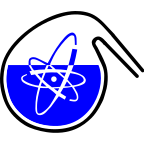Speaker
Description
Introduction: 119Sb is one of the most potent radionuclides for Targeted Auger Therapy due to convenient energy and numbers of Auger electrons as well absence of any other accompanying emissions [1-3]. Antimony-119 has a half-life of 38.5 hours which is well suited for radiotherapeutic application. In the present work: production, radiochemical separation and chelation preference of antimony radioisotopes were studied.
Production of antimony isotopes was performed by proton irradiation of a natural tin target with energies of 13 and 16 MeV as well as by neutron bombardment of natural tin and antimony. Radiotracers were used for establishing radiochemical procedures for isolating of bulk mass of tin from produced no-carrier-added antimony isotopes
Radiochemical separation: Dissolution procedure for irradiated tin target was established by using hydrochloric acid and hydrogen peroxide. Further liquid-liquid extraction with ethers or ketones was applied for separation of antimony from bulk tin mass. Methods based on solid phase extraction chromatography and ion exchange chromatography in various media were tested as well.
Chelation: Several common chelation systems along with some of the novel candidates from -pa family were tested to identify chelation preference of antimony radioisotopes.
Acknowledgments: We would like to thank Dr. Jan Kozempel from Charles University in Prague, Czech Republic and Dr. Steffen Happel from Triskem International, Bruz, France for synthesizing and providing samples of custom resins for Sn/Sb separation. TRIUMF receives federal funding via a contribution agreement with the National Research Council of Canada.
References:
- Bernhardt P et al. Low-energy Electron Emitters for Targeted Radiotherapy of Small Tumours, Acta Oncologica, 40:5, 602 (2001).
- Thisgaard H. et al. Sb119—A potent Auger emitter for targeted radionuclide therapy Medical Physics 35(9):3839 (2008).
- Thisgaard H. Production of the Auger emitter 119Sb for targeted radionuclide therapy using a small PET-cyclotron Appl Radiat Isot. 67(1):34(2009).

